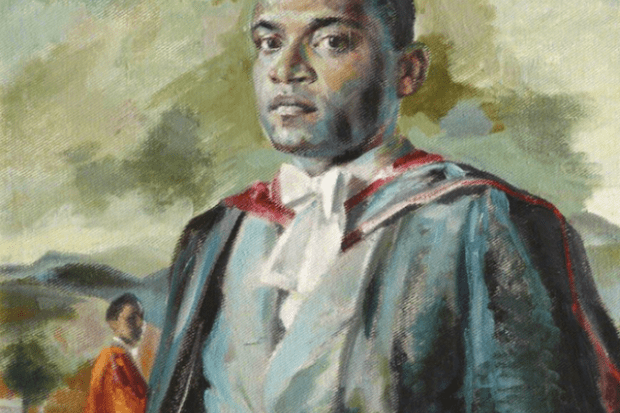Interventions that enhance the visibility of women and underrepresented minorities as scholars, teachers and leaders in academia are gaining momentum. A simple way to raise profiles and celebrate their accomplishments is to widen the range of people venerated on the walls of our buildings or exhibited in our museums and galleries. It is with this aim that the University of Oxford recently implemented a project to broaden Oxford’s representation of itself in its public spaces.
Unsurprisingly, the university, an 800-year-old institution, is dominated by historical portraits of its leading figures, who were over the centuries predominantly white and male. A few years ago, however, there emerged an ambition within the collegiate university to diversify its public portraiture. A catalyst was the 40th anniversary of the first all-male colleges to admit women students in 1975. Some commemorated their anniversary by removing dining-hall portraits of “dead white men” and replacing them with temporary exhibitions of portrait photographs of female fellows and graduates. Initially seen as bold, if not provocative, the move away from traditional-only iconography quickly gathered pace and led to the university-wide Full Picture initiative.
This project had three aims. One was to show that contrary to popular perceptions, Oxford has long been a diverse institution. The first women’s colleges opened in 1879, the first African student came to study law in 1876, and the first international student arrived in 1190. However, many historic contributions of women and minorities have gone unacknowledged. The project sought to commemorate and celebrate individuals whose achievements have not received the visibility they merit.
A second goal was to ensure that our buildings and the images they project are up to date and accurately reflect today’s university. Far removed from “Brideshead” legends, Oxford is a world leading and modern, dynamic university with a diverse staff and study body. Our students come from more than 140 countries, more than 50 per cent are female, 26 per cent are BME, and one in 10 have declared a disability. Our staff share similarly diverse backgrounds. “Oxford: The Full Picture” shows the truly rich diversity of our community.
The project’s third aim was to promote an inclusive university culture. Research shows that imagery, symbolism and public representation are powerful signals about who and what is valued, and can foster feelings of entitlement and belonging or ‘otherness’ and marginality. If we want all university members to have a shared sense of ‘belonging’ to the academic community and institution, it is vital that those publicly acclaimed on the walls around us reflect this aspiration. We also want potential students, the local community and others outside the university to feel welcomed by Oxford.
The project had two elements. We first catalogued the university’s existing portraits of pioneering figures whose achievements over the centuries challenged stereotypes of their time. More than 250 portraits of individuals at Oxford who came from minority or disadvantaged backgrounds were identified. They include Sir Hugh Springer, who came to Oxford from Barbados and went on to become the Governor-General of Barbados 1984, and The Honourable Vijaya Lakshmi Pandit, who became the first female Indian cabinet minister in 1937.
These and other portraits were captured and used in displays across the university – digital and physical – to give them greater prominence. They were on screens and posters in departments to introduce public lectures and in Twitter campaigns. The exhibition drew widespread interest and appreciation.
Building on this foundation, we assembled an advisory board of artists and university stakeholders, invited all university members to nominate candidates for new portraits of living Oxonians and appealed nationwide for artists to participate. We received more than 100 nominations and ended with a short list of 24 sitters and artists. These new portraits feature current academics such as Patricia Daley, professor of Geography, and former students, including Hilary Lister, sportswoman and sailor, and Jeanette Winterson, feminist and lesbian writer. They are magnificently diverse in age, gender, social class, sexual orientation and gender identity, ethnicity, disability and religion.
But all those featured share two things in common – they come from an underrepresented constituency and have demonstrated exceptional academic or other achievement and collectively illustrate that excellence comes in all shapes, sizes and colours.
The portraits were brought together in a high-profile exhibition in the Bodleian library last November and now has a permanent home in the University’s Examination Schools, one of our most prominent public spaces. It will not displace existing portraits, but will add to, balance and complement them. The exhibition has already encouraged many new initiatives, such as “Out in Oxford”, a trail across several university museums and libraries developed to highlight LGBT+ representation in their displays.
Diversifying portraiture is of course only one strategy among several in striving for an equal and inclusive institutional culture – and Oxford is clear both about its ongoing challenges and work-to-be-done. Nonetheless, I hope the new portraits will inspire the thousands of students and community members who use the building each year and will continue to generate interest and debate about who we value in our academic institutions and who is depicted and valued in public portraiture. I also hope that by using portraits – one of the most visible manifestations of who we are – the initiative will help to change public perceptions of what and who Oxford is today.
Rebecca Surender is advocate and pro vice-chancellor (equality and diversity) at Oxford University.
Register to continue
Why register?
- Registration is free and only takes a moment
- Once registered, you can read 3 articles a month
- Sign up for our newsletter
Subscribe
Or subscribe for unlimited access to:
- Unlimited access to news, views, insights & reviews
- Digital editions
- Digital access to THE’s university and college rankings analysis
Already registered or a current subscriber?



